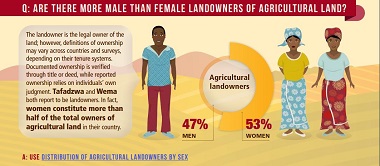The following post was originally published on the site of the CGIAR Research Program on Policies, Institutions, and Markets.
“Making sense of Land, Statistics and Gender”, a new infographic by the Gender and Land Rights database (GLRD) of the Food and Agriculture Organization of the United Nations (FAO) and CGIAR Research Program on Policies, Institutions, and Markets (PIM) explores the correct use of land ownership statistics (ownership understood in a broad sense beyond individual property rights) and highlights how gender can influence land rights.
The infographic invites viewers to travel to a rural community in Sub-Saharan Africa to meet Tafadzwa, Wema, and Chimango who tell us about their landownership. Despite our hosts being part of the same extended family and contribute to the family farm, the data collected about them differ greatly as a result of their relationships to each other and to agricultural land.
Land statistics disaggregated by sex are useful for showcasing the disparities in land rights between women and men and provide a sense of women’s economic empowerment in agriculture. Unfortunately, land statistics are not always used properly. “Making sense of Land, Statistics and Gender” helps interested stakeholders understand and interpret better the different land statistics available in FAO’s Gender and Land Rights Database (GLRD). Clarification on the correct use of land statistics will be fundamental for the successful monitoring of progress made under the new Sustainable Development Goals, particularly of targets related to reducing rural poverty and enhancing women’s empowerment.
For more information about the statistical methodology, click here.







